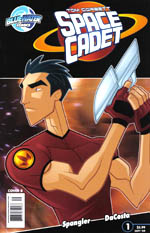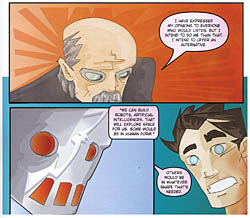 Written by Bill Spangler
Written by Bill Spangler
Art by John DaCosta
32 pages, color
Published by Bluewater Comics
I have to given Bluewater Comics credit where it’s due: I ended up reading the first two issues of Tom Corbett, Space Cadet entirely because of their title. It harkens back to old time, golden age science-fiction pulps, and the cover image of the three main characters standing heroically while a spaceship flies by pushes even more of those buttons. Once I read the comics, I can’t help but feel that in some ways it’s actually drawing on those old pulps and serials a little too much in spots.
Tom Corbett, Space Cadet primarily focuses on our main characters going to a Rescue Station in space to restock as as well as perform maintenance. Of course, things promptly go wrong as soon as they arrive, just like any old classic adventure story. The problem is, Bill Spangler’s script almost immediately leaps into some surprisingly clunky exposition to do so. I understand that Spangler is trying to deliver back story to the reader, explaining the make-up of the 23rd century—but there is certainly a more elegant way of doing so than what we see in the first two issues.  When a well-known celebrity appears in a memory recording, two characters describe him in explicit detail. The sad thing is, it’s often not necessary. Spangler’s script provides enough information elsewhere that its readers should be smart enough to put two and two together. It’s a lack of confidence in the reader "getting it," when it should just push forward. My biggest stumbling block, though, actually comes from the main characters. They come across as stereotypical as so many of those pulps do; the techy best friend worried about the machinery, the hot-headed guy who wants to break into the weapons locker, and of course our hero. I’m hoping with time they’ll feel a little more fleshed out, but right now there’s little else I feel like I’ve learned about them.
When a well-known celebrity appears in a memory recording, two characters describe him in explicit detail. The sad thing is, it’s often not necessary. Spangler’s script provides enough information elsewhere that its readers should be smart enough to put two and two together. It’s a lack of confidence in the reader "getting it," when it should just push forward. My biggest stumbling block, though, actually comes from the main characters. They come across as stereotypical as so many of those pulps do; the techy best friend worried about the machinery, the hot-headed guy who wants to break into the weapons locker, and of course our hero. I’m hoping with time they’ll feel a little more fleshed out, but right now there’s little else I feel like I’ve learned about them.
On the other hand, the plotting isn’t bad. Some characters seem to act certain ways only because the plot requires it (like one character suddenly deciding that they need to be careful of pirates despite there being no evidence at that point to push anyone in that direction), but with the second issue there’s a wide-reaching story forming involving ancient experiments, robots, and dwarf planets beyond the orbit of Neptune. I wasn’t thrilled in the first issue with the old writing trope of an introduction that doesn’t intersect with the rest of the issue, but at the end of the second one it looks like those two stories are finally coming together.
 John DaCosta is clearly a style you’re either going to instantly like or dislike. It’s a sketchy, loose style that uses just a handful of lines to put together its characters. There are pages where I look at DaCosta’s art and it instantly clicks together; it’s the sort of art where your eyes almost slide across the page, automatically filling in details for you where there might not otherwise be any. It’s a nice trick, your brain doing part of the work, but I like it there. The art is expressive and feels lively on those pages. There are occasional moments, though, where it ends up looking messy rather than stylized. I don’t know if some pages were drawn faster than others or what, but it’s certainly a style where if DaCosta’s not character it can shift from one extreme to the other. It’s a problem that is present in both issues, but hopefully with time it’ll be solid hits rather than the occasional miss.
John DaCosta is clearly a style you’re either going to instantly like or dislike. It’s a sketchy, loose style that uses just a handful of lines to put together its characters. There are pages where I look at DaCosta’s art and it instantly clicks together; it’s the sort of art where your eyes almost slide across the page, automatically filling in details for you where there might not otherwise be any. It’s a nice trick, your brain doing part of the work, but I like it there. The art is expressive and feels lively on those pages. There are occasional moments, though, where it ends up looking messy rather than stylized. I don’t know if some pages were drawn faster than others or what, but it’s certainly a style where if DaCosta’s not character it can shift from one extreme to the other. It’s a problem that is present in both issues, but hopefully with time it’ll be solid hits rather than the occasional miss.
Tom Corbett, Space Cadet has potential, but in terms of both writing and art it’s still clearly finding its way. Down the line I can see the rough edges getting removed, but just know for the moment that it’s still trying to get to where it wants to be. I’d like to see it succeed—there aren’t many strong science-fiction comics being published right now—but only time will tell if Spangler and DaCosta can hit their marks or not.
